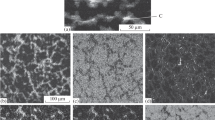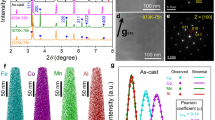Abstract
Efforts to develop and refine, by experiment, a model for the metallurgical behavior of Sm2(Co,Fe,Cu,Zr)17 alloys are reviewed. A summary of how the results of these studies have been utilized to improve, by 10 to 20%, the energy products of the 2:17-type magnets over a wide range of temperatures, up to 300 °C, is presented. The potential for further improvement of energy products and extension of the operating temperature range is assessed.
Similar content being viewed by others
References
H.P. Klein and A. Menth, “The Magnetic Properties of REC05 Single Crystals,” The Americal Institute of Physics, Conf. Proc. No. 18,Magnetism and Magnetic Materials, New York, 1177 (1973).
R.S. Perkins, S. Gaiffi, and A. Menth, “Permanent Properties of Sm2(Co,Fe)17,”IEEE Trans. Magn., MAG-11, 1431 (1975).
A.E. Ray and K.J. Strnat, “Easy Directions of Magnetism in Ternary R2(Co,Fe)17 Phases,”IEEE Trans. Magn., MAG-8, 516 (1972).
M. Sawaga, S. Fujimura, H. Yamamoto, Y. Matsuura, S. Hi- rosawa, and K. Hiraga, “Magnetic Properties and Microstructures of Rere Earth-Iron-Boron Permanent Magnet Materials,”Proc. 8th Int. Workshop on Rare Earth Magnets and Their Applications, University of Dayton Press, Dayton, Ohio, 587 (1985).
M. Sagawa, S. Fujimura, N. Togawa, H. Yamamoto, and Y. Matsuura, “New Material for Permanent Magnets on a Base of Nd and Fe,”J. Appl. Phys.,55,2083 (1984).
J.J. Croat, J.F. Herbst, R.W. Lee, and F.E. Pinkerton, “Pr-Fe and Nd-Fe-Based Materials: A New Class of High-Performance Permanent Magnets,”J. Appl. Phys., 55, 2078 (1984).
K.J. Strnat, “The Hard-Magnetic Properties of Rare Earth-Transition Metal Alloys,”IEEE Trans. Magn., MAG-8,511 (1972).
T. Ojima, S. Tomizawa, T. Yoneyama, and T. Hori, “Magnetic Properties of a New Type of Rare Earth-Cobalt Magnets,”IEEE Trans. Magn., MAG-13, 1317(1977).
A.E. Ray, “The Development of High Coercivity in 2:17 Type Rare Earth-Transition Metal Permanent Magnets,”Symp. Proc. Soft and Hard Magnetic Materials with Applications, ASM Materials Week ’86, ASM International, Metals Park, OH, 105 (1986).
U.S. Army Research Office, Contract No. DAAG-29-81-K-0120, DAAG-84-K-0012, and DAAL03-87-K-0082, Research Triangle Park, NC.
A.E. Ray, “A Model for the Metallurgical Behavior of Sm(Co,Fe,Cu,Zr)z Alloys,”Proc. 7th Int. Workshop on Rare Earth-Cobalt Magnets and Their Applications, Beijing, China, 261(1983).
A.E. Ray, “Metallurgical Behavior of Sm(Co,Fe,Cu,Zr)z Alloys,”J. Appl. Phys., 55, 2094 (1984).
A.E. Ray, “The Development of High Energy Product Permanent Magnets from 2:17 RE-TM Alloys,”IEEE Trans. Magn.,MAG- 20, 1614(1984).
A.E. Ray, W.A. Soffa, J.R. Blachere, and B. Zhang, “Cellular Microstructure Development in Sm(Co,Fe,Cu,Zr)8.35 Alloys,<IEEE Trans. Magn., MAG-23, 2711 (1987).
B. Zhang, J.R. Blachere, W.A. Soffa, and A.E. Ray, “AEM Studies of SmCo 2:17 Permanent Magnet Alloys,”J. Appl. Phys., 64, 5729(1988).
A.E. Ray, S. Liu, and J.D. Wolf, “Magnetic Properties of the Platelet Phase in Sm2TM17 Magnets,”Proc. 10th Int. Workshop on Rare Earth Magnets and Their Applications, The Society for Non-Traditional Technology, Tokyo, Japan, 255 (1989).
L.C.C.M. Nagamine, H.R. Rechenberg, and A.E. Ray, “Fe Site Populations in Sm2(Co,Fe)17 and Sm(Co,Fe,Cu,Zr)8.35 Alloys,”J. Magn. Magn. Mater., 89, L270 (1990).
A.E. Ray, “A Revised Model for the Metallurgical Behavior of 2:17 Type Permanent Alloys,”J. Appl. Phys., 67,4972 (1990).
S. Liu and A.E. Ray, “2:17 Type RE-TM Magnets with Improved Magnetic Properties,”Proc. 10th Int. Workshop on Rare Earth Magnets and Their Applications, The Society for Non-Traditional Technology, Tokyo, Japan, 265 (1989).
S. Liu and A.E. Ray, “Sm2(Co,Fe,Cu,Zr)17 Magnets with Higher Fe Content,”IEEE Trans. Magn., 25, 3785 (1989).
S. Liu, A.E. Ray, and H.F. Mildrum, “Temperature-Compensated 2:17 Type Magnets with Improved Magnetic Properties,”J. Appl. Phys.,67,4975 (1990).
S. Liu, A.E. Ray, and H.F. Mildrum, “Sintered Sm2(Co,Fe,Cu,Zr)17 Magnets with Light Rare Earth Substitutions, ”IEEE Trans. Magn., 26, 1382 (1990).
S. Liu, A.E. Ray, C.H. Chen, and H.F. Mildrum, “Magnetic Properties and Microstructures of Light Rare Earth Substituted 2:17 Magnets,”J.Appl. Phys., 69, 5853 (1991).
A.E. Ray, H.F. Mildrum, and J.B. Krupar, “Magnetic and Metallurgical Properties of Sm(Co,Fe,Cu,Zr)z Alloys Near z = 8.5,”IEEE Trans. Magn.,MAG-19,2044 (1983).
L. Rabenberg, R.K. Mishra, and G. Thomas, “Microstructures of Percipitation-Hardened SmCo Permanent Magnets,”J. Appl. Phys., 53,2389 (1982).
T. Bailey and I.R. Harris, “The Ageing Characteristics of a 2:17 Alloy; Coercivity, Microhardness, and Electrical Resistance Measurements,”Proc. 9th Int. Workshop on Rare Earth Magnets and Their Applications, DPH-GmbH, D-5340 Bad Soden, Germany, 435 (1987).
J.F. Herbst, J.J. Croat, R.W. Lee, and W.B. Yelon, “Neutron Diffraction Studies of Nd2(Co1-x Fex)17 Alloys: Preferential Site Occupation and Magnetic Structure,”J. Appl. Phys., 53, 250 (1982).
R. Kumar and W.B. Yelon, University of Missouri-Columbia, private communication (1989).
C.W. Allen, Argonne national Laboratory, private communication (1989).
N. Meguro, S. Tanigawa, M. Tokunaga, and H. Harada, “Study of Composition and Heat Treatment for Sm(Co-Fe-Cu-Hf)z Permanent Magnets,”Proc. 8th Int. Workshop on Rare Earth Magnets and Their Applications, University of Dayton Press, Dayton, OH, 239–1 to 239–17, (1985).
D. Sun, Q.Yi, H. Hong, C.He, and X. Jin, “Effects of Zr on the Microstructure and Magnetic Properties of 2:17 Magnets,”Proc. 7th Int. Workshop on Rare Earth Permanent Magnets and Their Applications, China Academic Publishers, Beijing, China, 477 (1987).
K. Akioka, M. Sakurai, and T. Shimoda, “Magnetic Properties of Resis-Bonded Sm.5Nd.4Ce.l(TM)8.35 Magnets,”IEEE Trans. Magn., MAG-23,2714 (1987).
K. Akioka, K. Ikuma, and T. Shimoda,“Pr-Substituted Sm2TM17 Bonded Magnets,”J. Jpn. Soc. Powder Powder Metall., 35, 584 (1988) (in Japanese).
J.C. Koo, “Partial Substitution of Sm with Neodymium, Prae- seodymium, and Mischmetal in RE2TM17 Magnets,”IEEE Trans. Magn., MAG-20, 1593(1984).
Author information
Authors and Affiliations
Rights and permissions
About this article
Cite this article
Ray, A.E., Liu, S. Recent progress in 2:17-type permanent magnets. JMEP 1, 183–191 (1992). https://doi.org/10.1007/BF02648616
Issue Date:
DOI: https://doi.org/10.1007/BF02648616




